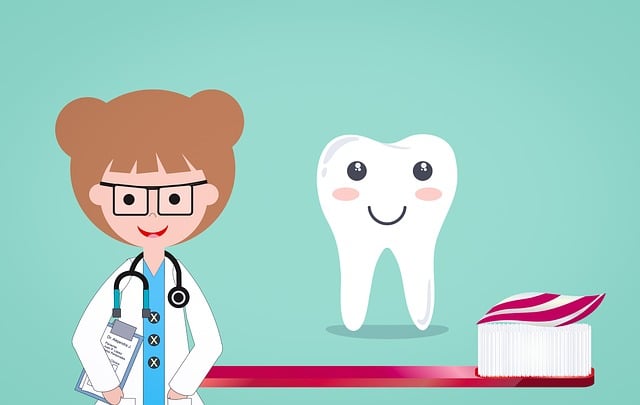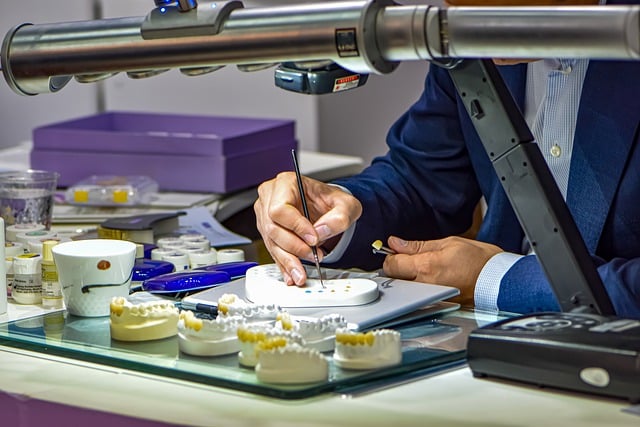In Newcastle upon Tyne's dental sector, advanced imaging technologies like X-rays and CT scans are crucial for precise diagnosis and treatment planning of dental conditions. These tools, including bitewing and panoramic radiographs, have revolutionized the approach to oral health care by allowing dentists to detect subtle issues early, leading to more effective and less invasive treatments for dental crowns and bridges. The integration of these imaging techniques has significantly improved patient outcomes in the region, with CT scans offering three-dimensional views that are particularly beneficial for surgical planning involving implants or complex procedures. Dental crowns and bridges play a vital role in restoring teeth' appearance and functionality, with custom-fitted solutions crafted by skilled dental professionals ensuring a natural look and durable fit. Patients are advised on post-treatment care to maintain the longevity of their restorations, with regular check-ups and professional cleaning crucial for long-term success. Dental crowns and bridges in Newcastle upon Tyne are now treated with advanced precision, setting a new standard for dental health services within the region.
Exploring the critical role of advanced imaging technologies such as X-rays and CT scans in uncovering dental ailments, this article delves into their indispensable use in Newcastle upon Tyne’s healthcare landscape. It sheds light on the intricacies of diagnosing oral health issues through these imaging modalities, highlighting their significance in the placement of dental crowns and bridges. From the application of various X-ray types to the pivotal role of CT scans in providing a complete picture of oral health, this piece offers an enlightening perspective on how these procedures enhance the longevity and success of dental restorations in the region. Furthermore, it outlines the essential post-procedure care and maintenance required for optimal outcomes with dental crowns and bridges, ensuring patients in Newcastle upon Tyne receive top-tier dental care.
- Unveiling Oral Health: The Role of X-rays and CT Scans in Diagnosing Dental Issues in Newcastle upon Tyne
- Understanding Dental Crowns and Bridges: How They Restore Smiles in the North East
- The Necessity of Precision: X-ray Types and Their Application in Dental Diagnostics
- Beyond the Surface: CT Scans and Their Importance in Comprehensive Dental Assessments
- The Procedure of Placing Dental Crowns and Bridges in Newcastle upon Tyne Clinics
- Post-Procedure Care and Maintenance for Long-Term Success with Dental Crowns and Bridges
Unveiling Oral Health: The Role of X-rays and CT Scans in Diagnosing Dental Issues in Newcastle upon Tyne

In the field of dentistry, advanced diagnostic imaging plays a pivotal role in unveiling the complexities of oral health. In Newcastle upon Tyne, the integration of X-rays and CT scans has significantly enhanced the ability of dental professionals to detect and address underlying issues that may not be visible during routine examinations. These imaging modalities are instrumental in planning for procedures such as the placement of dental crowns and bridges, ensuring that treatments are not only effective but also conservatively performed. X-rays, particularly in the form of bitewing and panoramic radiographs, provide valuable insights into the health of individual teeth, bone levels, and surrounding structures, enabling early intervention for conditions like cavities, periodontal disease, and impacted teeth. CT scans offer a more detailed three-dimensional view, which is particularly useful when assessing the density and integrity of bone prior to complex dental surgeries or implant placements. This advanced level of diagnostics not only improves patient outcomes but also contributes to the overall quality of dental care in Newcastle upon Tyne, where patients can receive tailored treatments with precision and confidence. Dental crowns and bridges, integral components of restorative dentistry, are meticulously planned with the aid of these imaging techniques to ensure optimal function and aesthetics, reflecting the high standards of dental care available in this region.
Understanding Dental Crowns and Bridges: How They Restore Smiles in the North East

In the North East, particularly in areas like Newcastle upon Tyne, dental crowns and bridges are integral components of restorative dentistry, serving to enhance both oral health and the aesthetics of a smile. Dental crowns are custom-made caps that fit over a damaged or decayed tooth, effectively restoring its shape, size, strength, and appearance. They are crafted from various materials, including porcelain fused to metal (PFM), all ceramic, or gold, each offering different advantages in terms of durability, aesthetics, and biocompatibility. The process of fitting a dental crown involves several steps, beginning with the dentist preparing the affected tooth and culminating in the placement of the permanent restoration, which is secured using dental cement. This procedure not only reinforces the tooth but also improves its function and integrates it seamlessly with your natural smile.
Bridges, on the other hand, are used to replace one or more missing teeth by anchoring artificial teeth to adjacent natural teeth, effectively ‘bridging’ the gap. In Newcastle upon Tyne, dental professionals employ both traditional bridges, which require crowns on the teeth adjacent to the gap, and implant-supported bridges for a more stable and long-lasting solution. The choice between these options depends on various factors, including the patient’s oral health status, the location of the missing tooth or teeth, and individual preferences. Both types of restorations not only enhance the ability to eat and speak but also play a significant role in maintaining the proper alignment of the remaining teeth, preventing further dental issues. With advancements in dental technology and materials, residents of the North East have access to high-quality, durable, and natural-looking crowns and bridges, ensuring that their smiles are as healthy as they are confident.
The Necessity of Precision: X-ray Types and Their Application in Dental Diagnostics

In the realm of dental diagnostics, the precision offered by X-rays and CT scans is indispensable in uncovering underlying oral health issues, particularly in the placement of dental crowns and bridges. Dental professionals in Newcastle upon Tyne, like those across the globe, rely on these imaging techniques to assess the condition of existing dental work, plan for new restorations such as crowns and bridges, and ensure the integrity of surrounding teeth and bone structure. Among the various types of X-rays used in dentistry, bitewing X-rays are particularly valuable for detecting decay or changes in the bone level around existing restorations or natural teeth. These X-rays provide a detailed view of the crowns of the teeth and the supporting bone, which is crucial when considering the placement of dental bridges or preparing for the installation of dental crowns. Periapical X-rays, on the other hand, offer a broader view of each tooth from its crown to the end of the root, essential for identifying issues that may arise post-procedure with crowns and bridges. In cases where a more comprehensive evaluation is required, CT scans provide three-dimensional images, offering dentists a clearer understanding of the complexities within and around the teeth, including any potential complications that could affect the longevity and success of dental restorations. This level of detail is particularly important in Newcastle upon Tyne, where the standard of dental care is high, and patients expect precise and effective treatments for their oral health needs.
Beyond the Surface: CT Scans and Their Importance in Comprehensive Dental Assessments

CT scans have revolutionized the field of dental diagnostics, offering a non-invasive method to assess oral health beyond the surface. In Newcastle upon Tyne, as in many places worldwide, dental professionals leverage this advanced imaging technique to detect and manage diseases that might not be apparent during a routine examination. CT scans provide high-resolution, three-dimensional images that allow for a detailed view of the jaw, teeth, and surrounding structures. This level of detail is particularly beneficial when evaluating the need for dental crowns or bridges, as it ensures precise fitting and optimal oral health outcomes. The 3D imaging provided by CT scans helps in planning complex dental procedures, ensuring that each restoration is tailored to fit seamlessly into the patient’s unique dental architecture. This meticulous approach not only enhances the aesthetic appearance of dental crowns and bridges in Newcastle upon Tyne but also contributes to their durability and longevity. The insight afforded by CT scans is indispensable for dental practitioners, enabling them to offer personalized treatment plans that cater to each patient’s specific needs, ultimately improving the quality of care provided within the region’s dental community.
The Procedure of Placing Dental Crowns and Bridges in Newcastle upon Tyne Clinics

In Newcastle upon Tyne, the process of placing dental crowns and bridges is a meticulous procedure carried out by skilled dental professionals to restore functionality and aesthetics to patients’ smiles. The initial step involves a thorough examination by a dentist to assess the affected tooth or the space where a bridge is needed. This evaluation determines the type of crown or bridge suitable for the patient. For crowns, the dentist will prepare the remaining tooth structure by removing any decay and shaping it to accommodate the crown. This preparation ensures that the final restoration is both stable and natural-looking. Impressions of the prepared tooth are then taken, serving as a model for the dental laboratory to craft the custom-made crown. In the interim, a temporary crown protects the prepared tooth until the permanent one is ready.
For bridges, the process is similar but involves multiple teeth. The supporting teeth on either side of the gap are prepared for crowns, and the space is fitted with a bridge that spans across it. The laboratory crafts the bridge to match the patient’s existing teeth, ensuring a seamless blend with the surrounding dentition. Once both the crown and bridge are ready, the patient returns to the clinic for fitting. The dentist checks the fit, make any necessary adjustments, and cements the restoration in place. Throughout this process, patients in Newcastle upon Tyne can expect personalized care and attention from their dental team, with follow-up appointments scheduled to monitor the health of the restored teeth and address any concerns.
Post-Procedure Care and Maintenance for Long-Term Success with Dental Crowns and Bridges

Patients in Newcastle upon Tyne who receive dental crowns and bridges are encouraged to adhere to a strict post-procedure care regimen to ensure the longevity of their restorative work. Immediately after the placement of these dental solutions, it is crucial to maintain optimal oral hygiene practices. This includes gentle brushing around the crown or bridge to prevent any inflammation or decay at the margins. While crowns are designed to cover a single tooth, and bridges span multiple teeth, both require attentive care to prevent complications such as gum disease or deterioration of the surrounding teeth.
For long-term success, regular dental check-ups are essential. These visits not only monitor the health of the crowns and bridges but also the adjacent natural teeth and supporting structures. Professional cleanings help remove any tartar or plaque that can accumulate, even with diligent home care. In Newcastle upon Tyne, dental professionals can provide personalized advice on maintaining your crowns and bridges. They may recommend specific oral hygiene products, such as interdental cleaners or softer toothbrushes, to ensure the health of both the restoration and the supporting gum tissue. By following these guidelines and maintaining a consistent oral care routine, patients can expect their dental crowns and bridges to function effectively and aesthetically for many years.
In conclusion, the utilization of X-rays and CT scans plays a pivotal role in diagnosing and treating dental issues in Newcastle upon Tyne. These imaging techniques are integral to the successful placement of dental crowns and bridges, ensuring that treatments are not only effective but also tailored to each patient’s unique needs. The diverse types of X-rays offer varying levels of detail, crucial for pinpointing problems below the gum line or within the jawbone. Similarly, CT scans provide comprehensive assessments that go beyond the surface, offering a three-dimensional view essential for complex cases. As such, residents of Newcastle upon Tyne can rely on advanced diagnostic procedures coupled with skilled dental professionals to maintain optimal oral health. The combination of these state-of-the-art technologies and expert care leads to long-term success with dental crowns and bridges, restoring smiles and enhancing the overall well-being of individuals in the region.
